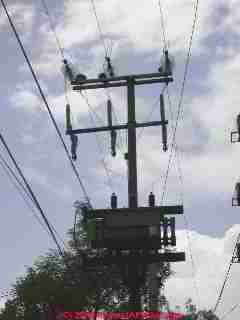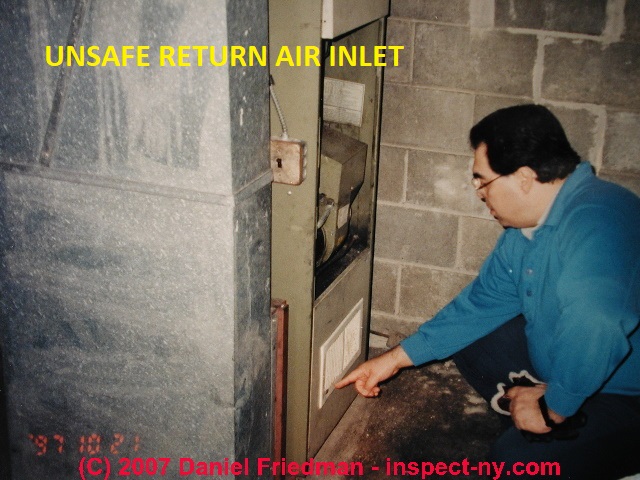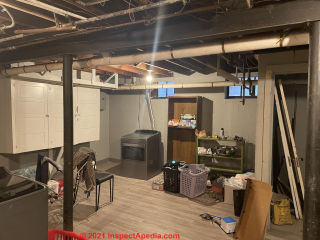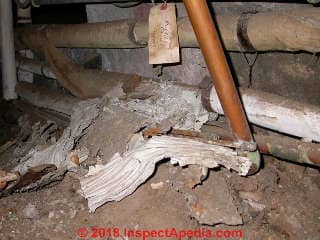 Hazard vs Risk
Hazard vs Risk
What's the Difference & Why You Care when Setting Priority of Building / Indoor Environment Repairs
- POST a QUESTION or COMMENT about managing risks from building environmental hazards
This article explains the difference between an environmental hazard and actual risk levels to building occupants from such hazards.
Making this less-than-obvious distinction between hazard and risk can help us decide when and how to spend money managing or addressing environmental and other hazards found in, on, and around buildings and their mechanical systems.
InspectAPedia tolerates no conflicts of interest. We have no relationship with advertisers, products, or services discussed at this website.
- Daniel Friedman, Publisher/Editor/Author - See WHO ARE WE?
Distinguish Between Hazard vs Risk At or In a Building
 Across many building, mechanical, structural, and environmental hazards discussed in articles found at InspectApedia.com, the most common concerns expressed by our readers are
Across many building, mechanical, structural, and environmental hazards discussed in articles found at InspectApedia.com, the most common concerns expressed by our readers are
- How dangerous is something scary that I've found in my building or read about somewhere?
- What should I do or spend on fixing this concern?
- How quickly should I take action?
Safety, environmental and health experts have for some time made an important distinction between hazard and risk that, until it has been explained, is not obvious to the rest of us.
Photo: we found these drums used to store toxic chemicals at the site of a home inspection in New York.
[Click to enlarge any image]
Hazards at Buildings
If a substance or building condition is called a hazard, that simply means that there is a potential for harm.
For example, experts have said that asbestos is a hazardous material and a potential carcinogen.
But that statement doesn't tell us anything about the specific level of actual risk of harm at a specific building where asbestos might be present.
Risks at Buildings
Unlike hazards just mentioned above, some safety and health experts refer to risk as the probability of and severity of harm (to building occupants or perhaps to the building itself, depending on what issue is being discussed).
In a discussion of the relationship between food safety and health, Clemens et al (2016) put it this way:
... it is important to remember a simple acronym, RITE (Risk Is Toxicity x Exposure)
The authors point out that some things that people are very worried about actually produce no plausible risk [we add that] while others can be very high risk and deserve prompt action.
An example is found in U.S. EPA and other authorities' advice about non-friable asbestos materials. Although asbestos is hazardous, asbestos materials that are not shedding or releasing asbestos dust into the occupied space and that are being left undisturbed are hazardous but do not present a meaningful risk to building occupants.
We'd add that other concerns we may find at, in, or on a building might pose a very high risk even if they're not the first thing that catches our attention.
For example, falling down the stairs is one of the most common hazards in buildings.
Why is the Difference between Hazard and Risk Important?
Clearly we don't have an endless supply of money, time, and attention, and because we need to make rational decisions about when to expend those on addressing a concern at a building, it is essential to consider risk, not just hazard.
If we fail to consider risk, we can spend enormous amounts of time and money on the wrong problem at buildings.
As we summarized above, health and environmental professionals point out that in assessing the actual risk of harm from a hazardous material such as an environmental contaminant or unsafe building material (asbestos, lead paint, pesticides, etc.) the actual risk depends on
- the toxicity of the material or substance
- the level of exposure of people to the substance or material
(this includes both how much material is present and the duration and other factors that affect the level of exposure such as temperature, exposure pathway such as skin, breathing, etc.)
But for many building materials or conditions that involve hazardous materials or substances as well as risk of health or economic harm, we can make a simpler analysis: how serious is this problem, what sorts of harm are involved, and how urgently should we act?
Example 1: don't let a low-risk or remote hazard cause you to ignore a close and immediate hazard that is high-risk
Above: a reader's measurement of magnetic field strength.
A home buyer was extremely worried about and planned to spend a significant sum investigating whether or not the electromagnetic fields from overhead power lines a mile away were going to cause injury to the home occupants.
The strength of EMF falls off as the square of the distance, so his EMF measurement "under the power line" did not give a useful indication of the risk closer to his home.
Yet he was so frightened that he was planning to install expensive (and ineffective) EMF shielding around the home.
But during the inspection we found stairs that had tall, rotting, uneven stair treads along a stairway with no handrails, an FPE electrical panel whose circuit breakers are known to fail to protect from fire and over-current at a significant rate, an unsafe chimney venting heating furnace that was back-drafting flue gases and potentially fatal carbon monoxide into the home, and a return air inlet right at the furnace, and several more immediate functional and safety concerns.
Our opinion was that even before considering the vulnerability of the building occupants or the duration of their exposure, the risks from those findings were far greater than the distant overhead electrical power lines.
See BACKDRAFTING HEATING EQUIPMENT
and compare those hazards to
EMF CANCER RISK from distant power lines.
Perspective on Risk of Injury or Death
The top three leading causes of preventable injury-related death – poisoning, motor vehicle, and falls – account for over 86% of all preventable deaths. No other preventable cause of death—including suffocation, drowning, fires and burns, and natural or environmental disasters—accounts for more than 5% of the total. - U.S. National Safety Council, To 10 Preventable Injuries (2023)
Similarly, The U.S. CDC, reporting on Top Ten Leading Causes of Death in the U.S. for Ages 1-44 from 1981-2020 notes that
- Unintentional injuries are the leading cause of death for Americans aged 1-44 years old.
- Unintentional injuries include opioid overdoses (unintentional poisoning), motor vehicle crashes, and unintentional falls.
- Suicide is now the 2nd leading cause of death for this 1-44 age group, and numbers of suicides continue to rise.
- Homicide remains in the top 5 leading causes of death for the 1-44 age group.
Example 2: Don't Confuse a No-Exposure or Insignificant Exposure that Doesn't Merit Action with a Significant Exposure Hazard & Risk
At ASBESTOS PIPE INSULATION a reader asked:
Is a small hairline dent worrisome on a asbestos plaster on pipe? - Anonymous 2023/09/01
We replied:
If your "small hairline dent" is the same as my idea of that sort of damage, my answer would be no.
Put another way, if asbestos- or asbestos-suspect pipe insulation is undamaged, that is, it's not shedding insulating material, then it's not releasing a meaningful enough amount of material to be considered a risk, even though asbestos itself is a hazardous material.
In contrast, the asbestos pipe insulation in the photo below is a hazard. Anyone who has to work in this space, say repairing a leaky pipe, faces a significant asbestos exposure risk because it's so difficult to move in the area without disturbing this friable material.
And there is additional risk that workers or building occupants track this friable asbestos insulation into the occupied spaces of the building as well.
Research on Environmental Hazard vs Risk
- ANSI/AIHA Z-10-2005, "Safety management, The New Benchmark for Safety Management Systems", AIHA, retrieved 5/20.2014, original source: http://www.asse.org/publications/standards/z10/docs/25-33Feb2006.pdf
- American Industrial Hygiene Association, AIHA, "Compendium of Risk Assessment/Risk Management Resources", (2002), retrieved 5/20/2014, original source: https://www.aiha.org/get-involved/VolunteerGroups/Documents/ RISKVG-%28Attachment%20F%29%20Compendium%20of%20risk%20assessment- risk%20management%20resources.pdf
- American Industrial Hygiene Association, AIHA, "AIHA Position Statement on Risk Assessment and Risk Management ", (2002), retrieved 5/20/2014, original source: https://www.aiha.org/government-affairs/PositionStatements/position02_Risk.pdf
- American Industrial Hygiene Association, AIHA, "AIHA White Paper on Risk Assessment and Risk Management", (2002), retrieved 5/20/2014, original source: https://www.aiha.org/government-affairs/WhitePapers/whitepaper02_Risk.pdf
- Clemens, Roger, A. Wallace Hayes, and Claire Kruger. UNDERSTANDING THE DIFFERENCE BETWEEN HAZARD AND RISK [PDF] Food Technol-Chicago 70 (2016): 18-19
Excerpts:
A fundamental understanding of the risk assessment process, including differentiating between real risk and a perceived hazard is critical.
To understand the hazard/risk relationships, there is a need to recognize four basic principles: dose matters, timing is critical, people differ, and things change. - Doe, John E., Alan R. Boobis, Samuel M. Cohen, Vicki L. Dellarco, Penelope A. Fenner-Crisp, Angelo Moretto, Timothy P. Pastoor, Rita S. Schoeny, Jennifer G. Seed, and Douglas C. Wolf. "The codification of hazard and its impact on the hazard versus risk controversy." Archives of Toxicology 95 (2021): 3611-3621.
- NSC, TOP 10 PREVENTABLE INJURIES [PDF] (2023) U.S. National Safety Council, 1121 Spring Lake Dr. Itasca, IL 60143-3201 USA, Tel: (800) 621-7615 Email: customerservice@nsc.org Web: nsc.org/ - retrieved 2023/09/02, original source: https://injuryfacts.nsc.org/all-injuries/deaths-by-demographics/top-10-preventable-injuries/
- Nordin, BE Christopher, Peter A. Baghurst, and Andrew Metcalfe. "The difference between hazard and risk in the relation between bone density and fracture." Calcified Tissue International 80 (2007): 349-352.
- OSHA, HAZARD COMMUNICATION STANDARD: SAFETY DATA SHEETS [PDF] OSHA, Occupational Safety and Health Administration, www.osha.gov retrieved 2021/05/02 original source: https://www.osha.gov/sites/default/files/publications/OSHA3514.pdf
Excerpts:
The Hazard Communication Standard (HCS) (29 CFR 1910.1200(g)), revised in 2012, requires that the chemical manufacturer, distributor, or importer provide Safety Data Sheets (SDSs) (formerly MSDSs or Material Safety Data Sheets) for each hazardous chemical to downstream users to communicate information on these hazards.
The information contained in the SDS is largely the same as the MSDS, except now the SDSs are required to be presented in a consistent user-friendly, 16-section format. This brief provides guidance to help workers who handle hazardous chemicals to become familiar with the format and understand the contents of the SDSs.
Employers must ensure that the SDSs are readily accessible to employees for all hazardous chemicals in their workplace. - Oyarzabal, Omar A., and Ellen Rowe. EVALUATION OF AN ACTIVE LEARNING MODULE TO TEACH HAZARD AND RISK IN HAZARD ANALYSIS AND CRITICAL CONTROL POINTS (HACCP) CLASSES [PDF] Heliyon 3, no. 4 (2017).
Abstract excerpt:
The terms hazard and risk are significant building blocks for the organization of risk-based food safety plans. Unfortunately, these terms are not clear for some personnel working in food manufacturing facilities. - Roberts, Abby, "Communicating the Difference Between Hazard and Risk", in "PSX 2023: The Hub of Product Stewardship" The Synergist, September 2023, p. 20, AIHA, American Industrial Hygiene Association, www.aiha.com
This brief article describes the content of an upcoming session at the 2023 PSX Conference scheduled for 18 October 2023 in Boston, MA. That session is
Yang, Garnick & Massarsky (hosts) Session J2, "Understanding Hazard Versus Risk Nuances of Consumer Products." - Roberts, Daniel. "Risk management of electrical hazards: Bridging the gap in understanding hazard versus risk." IEEE Industry Applications Magazine 19, no. 3 (2013): 21-26.
Abstract:
Most occupational health and safety (OHS) professionals understand the difference between hazard and risk. However, the distinction between these terms is not well understood in the electrical industry, where they are often used interchangeably.
This gap in understanding between OHS and electrical professionals needs to be bridged to ensure that electrical hazards, and the risks arising from those hazards, are effectively addressed. The objective of this article is to clarify the difference between hazard and risk and explain how OHS risk management principles can be applied to electrical hazards. - U.S. CDC, reporting on TOP TEN LEADING CAUSES OF DEATH IN THE U.S. FOR AGES 1-44 FROM 1981-2020 (2022) U.S. Centers for Disease Control, - retrieved 2023-09-02, origianl source: cdc.gov/injury/wisqars/animated-leading-causes.html
- US EPA, HEALTHY BUILDINGS, HEALTHY PEOPLE [PDF] (2001) U.S. Environmental Protection Agency
, Office of Air and Radiation
Introduction excerpt:
The importance of the indoor environment to human health has been highlighted in numerous environmental risk reports, including the 1997 report of the Presidential and Congressional Commission on Risk Assessment and Risk Management.
On average, we spend about 90 percent of our time indoors, where pollutant levels are often higher than those outside. Indoor pollution is estimated to cause thousands of cancer deaths and hundreds of thousands of respiratory health problems each year.
In addition, hundreds of thousands of children have experienced elevated blood lead levels resulting from their exposure to indoor pollutants. - US EPA, SAMPLING GUIDANCE for UNKNOWN CONTAMINANTS in DRINKING WATER [PDF] (2017) U.S. Environmental Protection Agency Office of Water (4601M) 1200 Pennsylvania Avenue, NW Washington, DC 20460 EPA-817-R-08-003
- Wang, Jiajun, Zhichao He, and Wenguo Weng. "A review of the research into the relations between hazards in multi-hazard risk analysis." Natural Hazards 104 (2020): 2003-2026.
...
Continue reading at FEAR-O-METER: Dan's 3 D's SET REPAIR PRIORITIES, or select a topic from the closely-related articles below, or see the complete ARTICLE INDEX.
Or see these
Recommended Articles
- ASBESTOS IDENTIFICATION IN BUILDINGS - home
- BASKETBALL MOLD SYNDROME - BBMS - a dirt smudge on the ceiling isn't dangerous
- BLACK MOLD, HARMLESS - high fear, no hazard, no risk for cosmetic black mold
- BLACK MOLD, TOXIC & ALLERGENIC - possibly dangerous but so may be molds of any other color too
- CARBON MONOXIDE - CO
- CELL PHONE RADIATION
- ENVIRO-SCARE - PUBLIC FEAR CYCLES
- ENVIRONMENTAL HAZARDS at BUILDINGS - home
- FEAR-O-METER: Dan's 3 D's SET REPAIR PRIORITIES - how worried should I be about ... ?
- FEAR of MOLD - MYCOPHOBIA
- GAS EXPOSURE EFFECTS, TOXIC
- HAZARD vs RISK - what's the difference? Something may be hazardous but the probability of occurance very small, and so less urgent.
- HOW MUCH SHOULD YOU PAY - for professional services?
- LEAD EXPOSURE HAZARDS INDOORS
- MORGELLONS SYNDROME - fear of fiberglass may be more harmful than the fiberglass itself
- OTHER PEOPLE's MONEY - if you push too hard people will spend your money to reduce their risk
- SAFETY HAZARDS GUIDE
- SLIP TRIP & FALL HAZARD LIST, STAIRS, FLOORS, WALKS
- WTC DUST PARTICLE - MICRO PHOTOGRAPHS
Suggested citation for this web page
HAZARD vs RISK at InspectApedia.com - online encyclopedia of building & environmental inspection, testing, diagnosis, repair, & problem prevention advice.
Or see this
INDEX to RELATED ARTICLES: ARTICLE INDEX to BUILDING ENVIRONMENT
Or use the SEARCH BOX found below to Ask a Question or Search InspectApedia
Ask a Question or Search InspectApedia
Try the search box just below, or if you prefer, post a question or comment in the Comments box below and we will respond promptly.
Search the InspectApedia website
Note: appearance of your Comment below may be delayed: if your comment contains an image, photograph, web link, or text that looks to the software as if it might be a web link, your posting will appear after it has been approved by a moderator. Apologies for the delay.
Only one image can be added per comment but you can post as many comments, and therefore images, as you like.
You will not receive a notification when a response to your question has been posted.
Please bookmark this page to make it easy for you to check back for our response.
IF above you see "Comment Form is loading comments..." then COMMENT BOX - countable.ca / bawkbox.com IS NOT WORKING.
In any case you are welcome to send an email directly to us at InspectApedia.com at editor@inspectApedia.com
We'll reply to you directly. Please help us help you by noting, in your email, the URL of the InspectApedia page where you wanted to comment.
Citations & References
In addition to any citations in the article above, a full list is available on request.
- In addition to citations & references found in this article, see the research citations given at the end of the related articles found at our suggested
CONTINUE READING or RECOMMENDED ARTICLES.
- Carson, Dunlop & Associates Ltd., 120 Carlton Street Suite 407, Toronto ON M5A 4K2. Tel: (416) 964-9415 1-800-268-7070 Email: info@carsondunlop.com. Alan Carson is a past president of ASHI, the American Society of Home Inspectors.
Thanks to Alan Carson and Bob Dunlop, for permission for InspectAPedia to use text excerpts from The HOME REFERENCE BOOK - the Encyclopedia of Homes and to use illustrations from The ILLUSTRATED HOME .
Carson Dunlop Associates provides extensive home inspection education and report writing material. In gratitude we provide links to tsome Carson Dunlop Associates products and services.





